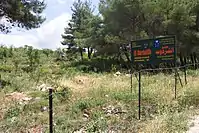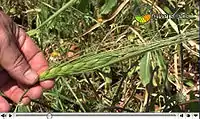Crop wild relative
A crop wild relative (CWR) is a wild plant closely related to a domesticated plant. It may be a wild ancestor of the domesticated (cultivated) plant, or another closely related taxon.

Overview
The wild relatives of crop plants constitute an increasingly important resource for improving agricultural production and for maintaining sustainable agro-ecosystems. Their natural selection in the wild accumulates a rich set of useful traits that can be introduced into crop plants by crossing.[1][2][3] With the advent of anthropogenic climate change and greater ecosystem instability CWRs are likely to prove a critical resource in ensuring food security for the new millennium.[4] It was Nikolai Vavilov, the Russian botanist who first realized the importance of crop wild relatives in the early 20th century.[5] Genetic material from CWRs has been utilized by humans for thousands of years to improve the quality and yield of crops. Farmers have used traditional breeding methods for millennia, wild maize (Zea mexicana) is routinely grown alongside maize to promote natural crossing and improve yields. More recently, plant breeders have utilised CWR genes to improve a wide range of crops like rice (Oryza sativa), tomato (Solanum lycopersicum) and grain legumes.[6]
CWRs have contributed many useful genes to crop plants, and modern varieties of most major crops now contain genes from their wild relatives.[7] Therefore, CWRs are wild plants related to socio-economically important species including food, fodder and forage crops, medicinal plants, condiments, ornamental, and forestry species, as well as plants used for industrial purposes, such as oils and fibres, and to which they can contribute beneficial traits. A CWR can be defined as "... a wild plant taxon that has an indirect use derived from its relatively close genetic relationship to a crop...”[8]
Conservation of crop wild relatives

CWRs are essential components of natural and agricultural ecosystems and hence are indispensable for maintaining ecosystem health.[4] Their conservation and sustainable use is very important for improving agricultural production, increasing food security, and maintaining a healthy environment.[9][10][11]

The natural populations of many CWRs are increasingly at risk. They are threatened by habitat loss through the destruction and degradation of natural environment or their conversion to other uses. Deforestation is leading to the loss of many populations of important wild relatives of fruit, nut, and industrial crops. Populations of wild relatives of cereal crops that occur in arid or semi-arid lands are being severely reduced by over grazing and resulting desertification. The growing industrialization of agriculture is drastically reducing the occurrence of CWRs within the traditional agro-ecosystems. The wise conservation and use of CWRs are essential elements for increasing food security, eliminating poverty, and maintaining the environment.[12]
Conservation strategies for CWRs often consider both in situ and ex situ conservation.[13][14] These are complementary approaches to CWR conservation, since each has its own advantages and disadvantages. For example, whilst ex situ conservation protects CWR (or more correctly, their genes) from threats in the wild, it can limit evolution and adaptation to new environmental challenges.
In 2016, 29% of wild relative plant species were completely missing from the world’s genebanks, with a further 24% represented by fewer than 10 samples. Over 70% of all crop wild relative species worldwide were in urgent need of further collecting to improve their representation in genebanks, and over 95% were insufficiently represented with regard to the full range of geographic and ecological variation in their native distributions. While the most critical priorities for further collecting were found in the Mediterranean and Near East, Western and Southern Europe, Southeast and East Asia, and South America, crop wild relatives insufficiently represented in genebanks are distributed across almost all countries worldwide.[15][16][14] A 2020 study found that 93.3% of wild relatives native to the United States are poorly represented in ex situ conservation repositories, while 93.1% are inadequately conserved in their natural habitats[17]
Examples of wild relatives
Grains
- Oats (Avena sativa) – Avena byzantina
- Quinoa (Chenopodium quinoa) – Chenopodium berlandieri
- Finger Millet (Eleusine coracana) – Eleusine africana
- Barley (Hordeum vulgare) – Hordeum arizonicum
- Rice (Oryza sativa) – Oryza rufipogon
- African Rice (Oryza glaberrima) – Oryza barthii
- Pearl Millet (Pennisetum glaucum) – Pennisetum purpureum
- Rye (Secale cereale subsp. cereale) – Secale cereale subsp. dighoricum
- Sorghum (Sorghum bicolor) – Sorghum halepense
- Broom millet (Panicum miliaceum) – Panicum fauriei
- Wheat (Triticum aestivum) – Einkorn wheat (Triticum monococcum)
- Maize (Zea mays subsp. mays) – Zea diploperennis
Vegetables
Note: Many different vegetables share one common ancestor, particularly in the Brassica family and plants. Many vegetables are also hybrids of different species, again this is particularly true of Brassicas.
- Asparagus (Asparagus officinalis) – Asparagus dauricus
- Beet (Beta vulgaris subsp. vulgaris) – Beta vulgaris subsp. maritima
- Black Mustard (Brassica nigra) – Wild mustard (Sinapis arvensis)
- Cabbage (Brassica oleracea var. capitata) - Brassica elongata
- Carrot (Daucus carota) – Daucus gracilis
- Garlic (Allium sativum var. sativum) – Allium atroviolaceum
- Leek (Allium ampeloprasum) – Welsh onion (Allium fistulosum)
- Lettuce (Lactuca sativa) – Prickly lettuce (Lactuca serriola)
- Mustard (Brassica juncea subsp. juncea) – Brassica carinata
- Onion (Allium cepa var. cepa) – Allium galanthum
- Rape (Brassica napus var. napus) – Common dogmustard (Erucastrum gallicum)
- Spinach (Spinacea oleracea) – Spinacia turkestanica
- Squash (Cucurbita pepo subsp. pepo) – Cucurbita okeechobeensis
- Turnip (Brassica rapa subsp. rapa) – Brassica rapa
Fruits
- Almond (Prunus dulcis) – Chinese plum (Prunus salicina and many others)
- Apple (Malus domestica) – mostly Malus sieversii, but with some cultivars perhaps belonging to Malus sylvestris or being a hybrid of the two.
- Apricot (Prunus armeniaca) – Prunus brigantina
- Avocado (Persea americana) – Persea schiedeana
- Banana – Musa acuminata and Musa balbisiana
- Breadfruit (Artocarpus altilis) – Jackfruit (Artocarpus heterphyllus)
- Cacao (Theobroma cacao) – Theobroma angustifolium
- Cherry (Prunus avium) – Prunus mahaleb
- Cucumber (Cucumis sativus) – Cucumis hystrix
- Eggplant (Solanum melongena) – Thorn apple (Solanum incanum)
- Grape (Vitis vinifera) – European wild grape (Vitis sylvestris). Hybrids exist also including other Vitis species.
- Grapefruit (Citrus paradisi) – Citrus medica
- Lemon (Citrus limon) – Citrus indica
- Mango (Mangifera indica) – Mangifera altissima
- Orange (Citrus sinensis) – Key lime (Citrus aurantiifolia)
- Papaya (Carica papaya) – Jarilla chocola
- Peach (Prunus persica var. persica) – Prunus tomentosa
- Pear (Pyrus communis) – Pyrus pyraster and Pyrus caucasica
- Pepper (Capsicum annuum) – Capsicum baccatum
- Pineapple (Ananas comosus) – Ananas bracteatus
- Plum (Prunus domesticus subsp. domestica)- Prunus spinosa and Prunus cerasifera
- Pumpkin (Cucurbita maxima subsp. maxima) – Cucurbita ecuadorensis
- Strawberry (Fragaria× ananassa)
- Tomato (Solanum lycopersicum) – Solanum chilense
- Watermelon (Citrullus lanatus var. lanatus) – Bitter apple (Citrullus colocynthis)
Oilseeds
- Peanut (Arachis hypogaea subsp. hypogaea) – Arachis duranensis
- Sunflower (Helianthus annuus) – Helianthus exilis
- Soya (Glycine max) – Glycine clandestina
- Safflower (Carthamus tinctorius) – Carthamus creticus
- Rapeseed (Brassica napus) – Brassica rapa, Brassica oleracea
Pulses
- Lentil (Lens culinaris) – Lens ervoides
- Garden Pea (Pisum sativum) – Pisum fulvum
- Butter Bean (Phaseolus lunatus) – Phaseolus augusti
- Garden Bean (Phaseolus vulgaris) – Phaseolus coccineus
- Faba Bean (Vicia faba) – Vicia johannis
- Grasspea (Lathyrus sativus) – Lathyrus tuberosus
- Cowpea (Vigna unguiculata) – Vigna monantha
- Bambara groundnut (Vigna subterranea) – Vigna hosei
- Pigeonpea (Cajanus cajan) – Cajanus albicans
- Chickpea (Cicer arietinum) -
- Vetch (Vicia sativa) – Vicia barbazitae
- Alfalfa (Medicago sativa)
- Adzuki bean (Vigna angularis var. angularis) – Vigna umbellata
- Black gram bean (Vigna mungo var. mungo) – Vigna grandiflora
- Mung bean (Vigna radiata var. radiata) – Vigna stipulacea
Tubers
- Sweet potato (Ipomoea batatas) – Ipomoea triloba
- Cassava (Manihot esculenta subsp. esculenta) – Manihot walkerae
- Potato (Solanum tuberosum) – Solanum chacoense
See also
References
- Bioversity International, (2006). Crop wild relatives. Bioversity International, Rome.
- FAO, (1998). The State of the World’s Plant Genetic Resources for Food and Agriculture. FAO, Rome
- FAO, (2008). Establishment of a global network for the in situ conservation of crop wild relatives: status and needs. FAO, Rome
- Maxted N, Ford-Lloyd BV, Kell SP (2008). "Crop wild relatives: establishing the context.". In Maxted N, Ford-Lloyd BV, Kell SP, Iriondo J, Dulloo E, Turok J (eds.). Crop Wild Relative Conservation and Use. Wallingford: CABI Publishing. pp. 3–30.
- Vavilov NI (1926). Studies in the origin of cultivated plants. Leningrad: Institute of Applied Botany and Plant Breeding.
- Hajjar R, Hodgkin T (2007). "The use of wild relatives in crop improvement: a survey of developments over the last 20 years". Euphytica. 156 (1–2): 1–13. doi:10.1007/s10681-007-9363-0. S2CID 36269581.
- Dempewolf H, Baute G, Anderson J, Kilian B, Smith C, Guarino L (2017-05-06). "Past and Future Use of Wild Relatives in Crop Breeding". Crop Science. 57 (3): 1070–1082. doi:10.2135/cropsci2016.10.0885. ISSN 0011-183X.
- Maxted N, Ford-Lloyd BV, Jury SL, Kell SP, Scholten MA (2006). "Towards a definition of a crop wild relative". Biodiversity and Conservation. 15 (8): 2673–2685. doi:10.1007/s10531-005-5409-6. S2CID 26885014.
- Hawkes JG, Maxted N, Ford-Lloyd BV (2000). The ex situ conservation of plant genetic resources. Dordrecht: Kluwer. pp. 1–250.
- Heywood VH, Dulloo ME (2006). "In Situ Conservation of Wild Plant Species – a Critical Global Review of Good Practices. IPGRI Technical Bulletin No. 11. IPGRI, Rome". Cite journal requires
|journal=(help) - Meilleur BA, Hodgkin T (2004). "In situ conservation of crop wild relatives: Status and trends". Biodiversity and Conservation. 13 (4): 663–684. doi:10.1023/b:bioc.0000011719.03230.17. S2CID 3064850.
- Tanksley SD, McCouch SR (August 1997). "Seed banks and molecular maps: unlocking genetic potential from the wild". Science. 277 (5329): 1063–6. doi:10.1126/science.277.5329.1063. PMID 9262467.
- Khoury CK, Heider B, Castañeda-Álvarez NP, Achicanoy HA, Sosa CC, Miller RE, et al. (2015-04-21). "Distributions, ex situ conservation priorities, and genetic resource potential of crop wild relatives of sweetpotato [Ipomoea batatas (L.) Lam., I. series Batatas]". Frontiers in Plant Science. 6: 251. doi:10.3389/fpls.2015.00251. PMC 4404978. PMID 25954286.
- Taylor NG, Kell SP, Holubec V, Parra-Quijano M, Maxted N (2017). "A systematic conservation strategy for crop wild relatives in the Czech Republic" (PDF). Diversity and Distributions. 23 (4): 448–462. doi:10.1111/ddi.12539.
- Castañeda-Álvarez NP, Khoury CK, Achicanoy HA, Bernau V, Dempewolf H, Eastwood RJ, et al. (March 2016). "Global conservation priorities for crop wild relatives". Nature Plants. 2 (4): 16022. doi:10.1038/nplants.2016.22. PMID 27249561. S2CID 7174536.
- Khoury CK, Castañeda-Álvarez NP, Dempewolf H, Eastwood RJ, Guarino L, Jarvis A, Struik PC (2016). "Measuring the state of conservation of crop diversity: a baseline for marking progress toward biodiversity conservation and sustainable development goals". Crop Wild Relatives Policy Brief: 6. hdl:10568/74483.
- Khoury, Colin K.; Carver, Daniel; Greene, Stephanie L.; Williams, Karen A.; Achicanoy, Harold A.; Schori, Melanie; León, Blanca; Wiersema, John H.; Frances, Anne (2020-12-10). "Crop wild relatives of the United States require urgent conservation action". Proceedings of the National Academy of Sciences. doi:10.1073/pnas.2007029117. ISSN 0027-8424. PMID 33318205.
External links
- Crop Wild Relatives Inventory and Gap Analysis
- European Crop Wild Relative Diversity Assessment and Conservation Forum
- Beyond the Gardens: The Crop Wild Relatives Project (Vimeo Video)
- A short video on emmer wheat.
- Short DIVERSEEDS video on crop wild relatives in the fertile crescent in Israel
- Atlas of Guatemalan Crop Wild Relatives
- Bioversity International - Crop Wild Relatives
